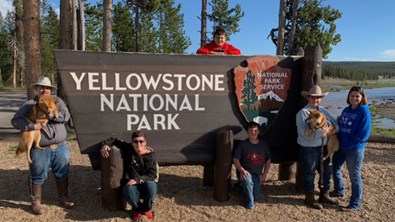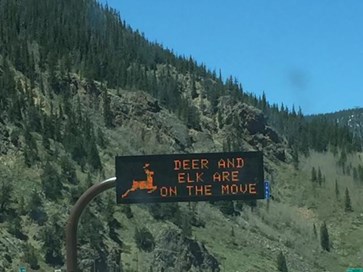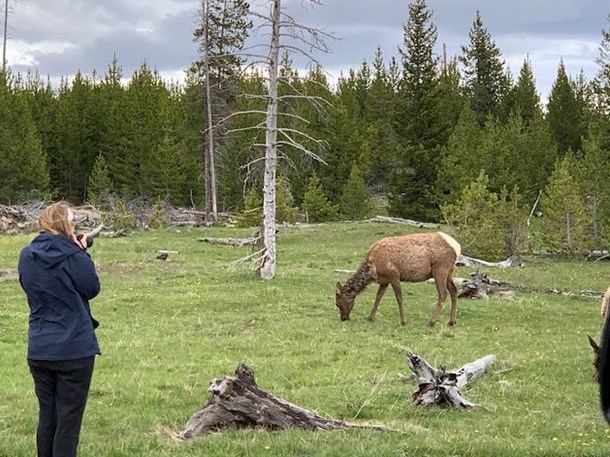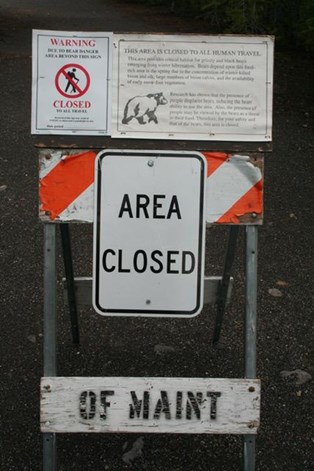
Wildlife watching appeals to everyone: from birdwatchers to campers to hunters in the off-season. This is a great time to get outdoors to observe wildlife in their habitats, watching their movement and behavior patterns, and capturing moms raise their young born just a few months earlier. Bears are coming out of hibernation, elk are calving, and deer are nurturing their fawns. There is an added advantage to hunters. This is the time to get out to study wildlife tracks, scout habitats where game animals frequent, and learn the patterns and signs of wildlife in nature.
It is especially important to do your research if you are traveling where wildlife are known to roam. Do your homework and study the areas you will be traveling to identify what wildlife lives in those habitats. Even if you are familiar with living near wildlife, it is always a good idea to refresh your knowledge.

The author and her family have made many treks to Yellowstone National Park to safely and respectfully observe the vast array of wildlife that call it home.
One of the most visited National Parks in the world is Yellowstone National Park, located in northwestern Wyoming. Yellowstone is an incredible place to view wildlife. All the large mammals that were present when Yellowstone first became a National Park in 1872 are still roaming the landscape today. These wildlife species include grizzly and black bears, wolves, mountain lions, elk, bison, pronghorn, moose, and bighorn sheep. Not to mention the hundreds of other species ranging from birds to small mammals, reptiles to amphibians and aquatic life. For these larger animals, there are rules in place to keep not only the visitors safe, but the wildlife as well.

Wildlife is dangerous. Although many of the animals may look meek and mild, they are not. Wild animals are not pets. They are not domesticated nor tamed by humans, no matter how many people pass them by each day.
Stay Back
There are strict guidelines in place to keep everyone and every animal safe. One of the most important rules strictly enforced in National Parks is to never approach wildlife. If you are hiking or picnicking in an area and you see wildlife emerging nearby, leave the area safely. Pack up your gear and move further away from the potential encounter. Never follow or approach an animal to attempt to touch it or try to get closer to it to take a picture.

Although it's fascinating to be up close to wildlife, this tourist is still too close for comfort.
If you do spot wildlife, consider yourself lucky because this is why you came on your journey! There are things to do to stay safe and be a responsible visitor. In Yellowstone National Park, bison, grizzly bears, black bears and elk injure and kill people each year. It is for this reason there are strict rules in place. People must stay at least 100 yards away from bears and wolves, and at least 25 yards away from all other animals, including bison and elk. You can capture some amazing photos from these distances safely.

Feeding
Never feed wild animals. Human food is bad for wildlife since they cannot digest processed foods. If you offer them natural food, they become dependent upon humans as a food source. Not only is it wrong to feed wildlife, but it is also illegal in many states regardless if you are in a national park, state park, or on private property. For example, in Texas it is illegal to feed an alligator anywhere in the state.
Furthermore, if a wild animal is fed by humans, they may soon become desensitized to people and start approaching humans and become aggressive. They may lose their natural fear of humans. Never feed small mammals or birds. For the larger animals, if this occurs, a conservation officer or ranger may have to either trap and relocate the animal or dispatch the animal to remove it from the population to prevent future human encounters. There is a saying “a fed animal is a dead animal.”
Wildlife Watching
Many animals increase their movement in the early mornings and late evenings. This is the time of day when the temperature is generally cooler, and wildlife is most actively moving about caring for their young and feeding. Oftentimes other visitors are attentive to these behavioral patterns and are on the roadways with you, also searching for wildlife to view and photograph. In National Parks, it is illegal to spotlight wildlife by viewing them with the use of artificial light. It is also illegal to call or use calling devices to attract wildlife, such as howling at the wolves, bugling at the elk, or making bird calls of any kind. It is also illegal to use any type of electronic equipment such as drones to track wildlife while in National Parks.

If you see an animal and wish to spend some time watching and photographing it, find a safe place to completely pull off the road. Most National Parks have a white line on either side of the road, and the rules state you must have all four tires fully to the right of the white line if you are pulling over. Many roads have pull-outs and parking areas to safely view wildlife. Always be aware of other drivers since most everyone around you will also be looking for wildlife. It is not uncommon to have someone in front of you slam on their breaks if they see something in the distance.
Be courteous of others who are nearby. If you are enjoying the scenery or trying to capture the perfect photo, be aware of others who may also be doing the same. Keep talking to a whisper, and noises to a minimum. Avoid slamming car doors and locking your vehicle with the audible “beep” or “honk.” If there is cell service where you are located, keep your phone on silent or vibrate. People often like to take videos and there is nothing more irritating than having someone else’s voice or cell phone ringing over your perfect recording.
Wildlife is here for everyone to enjoy. Those who abuse that privilege not only risk their own safety but the safety of the animal and rob others of the enjoyment of viewing these magnificent creatures. When an animal is removed from the population because someone did not follow the rules, the next generation of that animal is lost.














































